Avi's Blog, page 6
October 8, 2024
Immigrants

If you are learning about the Unites States of America, you are learning about the history of immigrants to North America. The first Europeans (Vikings) came to America in 1021, and the most recent immigrants came, well, today.
When a certain Lawrence Washington died (1654) in England in poverty, his son John Washington emigrated to the American colonies — and became the ancestor of George Washington.
On my father’s side, my grandfather came to NYC in 1891 or 1893. The record is unclear. On my mother’s side, the year of arrival was 1890. The family story is that my great grandmother (and her five children) passed through England on the way. Pausing amidst the great labyrinth of the Liverpool docks just before departing, Great Grandma (known as “Little Grandma” because of her five-foot size) left the children and went off (to find a bathroom?) only to come back to find Charles (my grandfather, aged two) missing. A frantic search ensued, and just as the ship was about to leave, he was rescued from an aimless walk.
I suspect that there are countless American family stories akin to that one, the journey to point of departure, the voyage itself, the arrival, and early years of tragedy and/or triumph.
In fact, my grandfather — the Charles cited above — became a social worker, whose particular focus was reuniting married couples who immigrated at different times. It was common for the husband to come first, and only gradually earn enough money to bring the family over, not always with happy results. (See Hester Street, the 1975 film.)
It is one of the curiosities of American history, that though its history is also a history of immigration, immigrants have always been deplored, resisted, and disparaged — even as they continued, and continue) to come.
Peter Stuyvesant, (1610–1672) the governor of the Dutch Colony of New Amsterdam, (which would become NYC) was rebuked by the Dutch government for his not wanting to allow Jewish immigrants to come into the colony. Today Stuyvesant lends his name to one of the most prestigious high schools in the city.
Our history of slavery is a history of forced immigration — two and a half million. We sometimes forget that the Statue of Liberty — referenced most often as a monument celebrating immigration — was erected to proclaim the end of American slavery — and forced immigration.
In the 18th century, England had widespread forced immigration of felons — by the many thousands — were sent to the colonies as a form of legal punishment.
Then there was the 19th century Know Nothing Party, which gained considerable importance just before the Civil War, in large measure because of its violent anti-Irish Catholic immigration agitation. A hundred years later there was considerable resistance in the country to the candidacy of John F. Kennedy for the same anti-Catholic bias.
The western railroads could not have been built without Chinese immigration, even as those people were deeply discriminated again.
Thus it goes.
So if you are engaged in American history — as I am — to look at immigration in one form or another (voluntary or forced) it should come as no surprise that I’ve written about it a few times: Night Journeys, The End of the World and Beyond, City of Orphans, Beyond the Western Sea, and now Lost in the Empire City.
(The term “Empire City,” better known as New York City, is said to have had that nickname bestowed upon it by none other than George Washington. See above.)
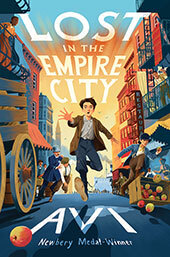 Lost in the Empire City tells the story of Santo Alfonsi, who (in 1910) with his mother, brother and sister, follow their father to America, only for the boy to become separated when passing through Ellis Island. He lands in NYC, alone.
Lost in the Empire City tells the story of Santo Alfonsi, who (in 1910) with his mother, brother and sister, follow their father to America, only for the boy to become separated when passing through Ellis Island. He lands in NYC, alone.
Does he find his family? Were they sent back to Italy? What happens to his father? That’s all part of story. Though I like to think of the story as unique, it’s also probably a story which will resonate with many of my readers.
That’s one of the great bounties of fiction: stories we invent can remind us about what we often have forgotten.

October 1, 2024
The Oldest Book on My Shelves
My parents, in their early college years, both wanted to be writers. My father, if I recall correctly, admired Joseph Conrad. My mother, along with her sister, aspired to be the new Bronte sisters. They went on to do other things, and only wrote for their professions. It did mean, however, that I grew up in a house of books.
Our mother read to me, and my siblings, every night. Friday was the day for weekly library visits. At some point I was allowed to walk to that local public library and did so, often, with my own library card. There was a used bookstore in the neighborhood, and in its far back were kids’ books, cheap.
[I describe both that library and the bookstore in my novel, Catch You Later Traitor.]
Every birthday, every Christmas, I received at least one book. As kids we were encouraged to have our own book collections.
It’s not really a surprise then, that on my shelves I have a few — very few — books from my childhood.

The oldest is a picture book, Giant Otto, by William Pene Du Bois. My copy was published in 1936. (It is still in print) I have a vague memory of getting this book as a gift from my father when we were visiting my grandparents’ house. He seems to have been away. It would have been during World War II, and since he was in the Coast Guard, that might explain his absence.

The second book is an “Illustrated Junior Library” edition of The Arabian Nights. On the first page of this book there is this handwritten inscription:
“To Edward from his friends. Susan. Biff. John. Ann Elizabeth. December 23, 1947.” The friends’ names are each in different handwriting.
Edward is my first (real) name and that date is my 10th birthday.
My guess is that I (and my twin sister) were having a birthday party, and these friends got together to buy me a present. Alas, I have no memory of those friends.
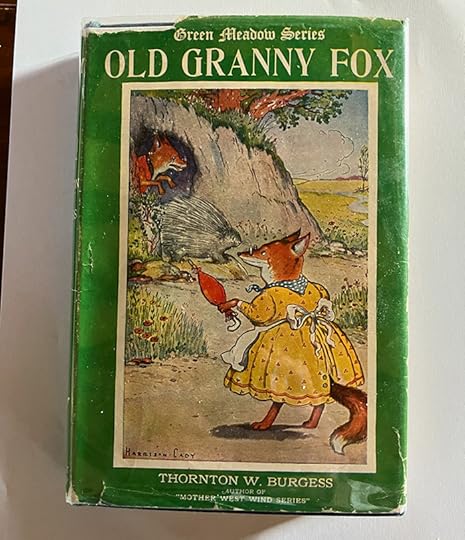
The third book is Old Granny Fox, by Thornton W. Burgess. This was perhaps one of the first chapter books I read on my own, the first adventure novel. I was able to buy them — the Green Meadow Series — at that used bookstore I mention above. I think they cost me twenty-five cents (allowance money) and I bought, and read, many of them. This is the only one left.
In time I would read them to my own kids.

I have little doubt that these animal stories led to me The Wind in the Willows, by Kenneth Grahame. (No date on my copy) I’m not sure when I came to the book but I loved both the characters and the writing, though I did not understand the mystic pantheistic chapters. I have read the book many times, even as an adult. I still find it wonderful.
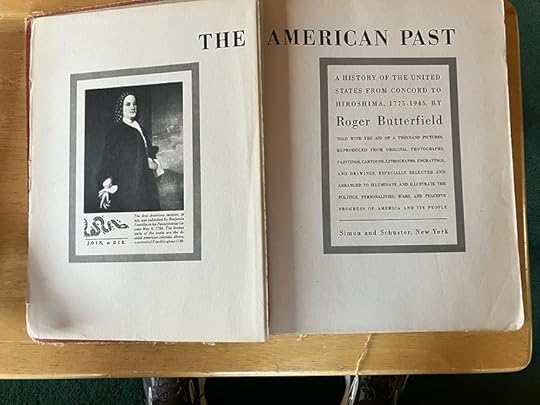
The final old book, The American Past, by Roger Butterfield, was a lavishly illustrated history of the United States, the first of its kind. My edition is from 1947, (first edition, second printing). It remains in print (10th edition) on Amazon. I am sure that my parents purchased this book as a way of teaching us US history. I can’t speak for my brother and sister, but I was fascinated by the text and illustrations and went through it countless times.
The only important childhood book I don’t have is the copy of Treasure Island I first read.
What is curious about these titles, animal stories, adventure, history, is how I find echoes of them all in my own books. It’s a reminder that the books we read when young — children’s books — can be enormously important to our lives. We keep them on our shelves or in our heads. They become a vital part of who we are, even when we lose them.
I’m lucky enough to still have these few.
What is the oldest children’s book on your shelves?
September 24, 2024
Soup’s On
 Last night didn’t start well.
Last night didn’t start well.
It began when my wife and I sat down to a new soup recipe from a new cookbook that I was excited to get and use. That soup took me two hours to make, but only about thirty seconds — after our first spoonfuls — to exchange looks that mutually said, “This is awful.”
Happens.
I found something else to eat and then — by way of solace — went back to work on the new book I had just started that day, trying to get a first chapter into a shape that would engage a reader, any reader.
Alas, it was as bad as the soup.
It didn’t, I told myself, start right.
So I went to bed thinking I need to come up with a good first line. If I can just get that….
There’s a persistent romantic story about writing that suggests that one can dream up — truly dream — a good story. Alas, I’m not someone who remembers dreams. That said, dreaming up a story has happened to me three times over the course of my career.
The first time it came about shortly after I wrote the book, Night Journeys (1979). It had a decent ending, but it was an ending that fairly begged the question: The two main characters get away free, but what happens to them?
I must have been thinking hard about this question, because not long after I went to bed and dreamed up the answer, waking up with virtually the whole plot of a sequel in my head. In a short time that dream would become Encounter at Easton (1980) In essence, I followed my memory to write the book.
The second time this happened was in (2012) and was much more notable. I had, as it were, discovered the English Middle Ages, and wanted to find a story fitting that time that I could write about, so I had been reading a lot about the period.
Sure enough, one night I dreamed up a story. Not only did I dream it, but I also (in my dream) broke the tale down into four books, and even had the very last line of the fourth book.
I set about to write the first volume. It became Crispin: The Cross of Lead.
Only when the book won the Newbery did I remember that whole dream and plunged on and wrote two more volumes both based on that dream. (Crispin at the Edge of the World, and Crispin, The End of Time.) The fourth volume was begun but then abandoned by the publisher. I’d still love to write it, remembering as I do, yes, that very last line.
Now all this is prelude to the fact that as related above, last night I went to bed telling myself I needed a good opening line to my new book.
When I woke this morning at 5:30 I had it.
It’s good to know that when my body gives up, the mind can still churn on.
Then again, maybe it was that bad soup.
Happy dreams!
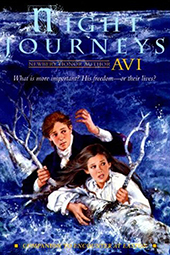
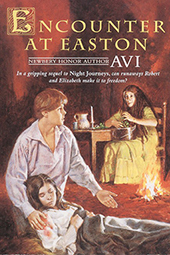
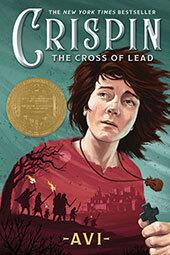
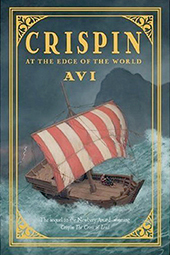
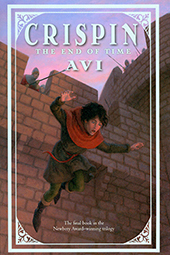
September 17, 2024
I am working on a new book

It was on March 7, 2012, that I began this blog and posted an entry. That is, more than ten years ago I wrote:
“I am working on a new book. It’s so new it has no title, and to be honest, I’m not sure what will happen. Certainly, no ending is in sight. But it’s different, I think, than anything I have written before, so I’m having a good — if hard — time.”
I’m unclear what book I was working on back then (Perhaps Catch You Later, Traitor) but if I were to write a summary statement as to what I am doing today it might read:
“I am working on a new book. It’s so new it has no title, and to be honest, I’m not sure what will happen. Certainly, no ending is in sight. But it’s different, I think, than anything I have written before, so I’m having a good — if hard — time.”
The curious truth is that every book I write feels different (even sequels) and every book I write is hard to create. The fact that I have been writing for more than sixty years doesn’t make the ongoing work any easier. What all my experience has taught me is that if I keep working, I get somewhere though I am unsure what that destination might be. I just want to get there.
Because if there is one thing that allows me to keep going — other than the need to make a living — is that each story is different, with a different situation, and a different cast of characters so that every tale is new for me, too. I love stories, and it must be understood that I am telling myself a new story each time.
If I am at the stage when I am working with an editor, I am (hopefully) being pushed to know more about the story, more about the characters, and more about the emotions that flow from it all. Many a time I am pushed in such a way that I discover more about the story I am working on even as I am revising it. This happens when the characters become separate from me, develop a life, and demands of their own, so that I am — as it were — observing them from some distance. That is writing — for me, anyway — at its best.
It may sound rather simplistic, but I am writing so I can find out what happens. In other words, when the writer in me becomes the reader, I am exactly where I want (and love) to be.
If I could sum it up, I might say writing for me is — finding a new story. I only hope I like it.
September 10, 2024
Great Expectations

Having been the parent of six children, Labor Day — with the return of school — has always meant the beginning of the year for me. Never mind January One. As far as I am concerned, this is the time when the year truly starts. And this year, within the space of a few days, I have one grandchild starting college and another starting kindergarten.
(For my part I recall the year always began with a pencil box, a small box, carefully selected at the five and dime store, which contained pencils, eraser, pen, six-inch wooden ruler. and a protractor for drawing circles, which I don’t believe I ever used)
All this created a remembrance of great expectations.
Just thinking of the term “Great Expectations,” in turn caused me to pick up my copy of Charles Dickens novel of the same name.
There are any number of reasons why this is my favorite of his novels. Actually, I think it is one of the truly great novels.
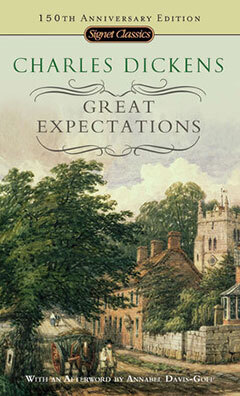 Dickens wrote the book out of urgent need. His magazine — All the Year Round — which published serial novels, was in trouble. The then current major novel (A Day’s Ride by Charles Lever) was attracting a diminishing number of readers. In order to boost readership, Dickens began to write and publish Great Expectations. That Dickens wrote the book because of financial need has always been a teaching point for me. Never mind the romance of writing. Write to find a way to pay the bills!
Dickens wrote the book out of urgent need. His magazine — All the Year Round — which published serial novels, was in trouble. The then current major novel (A Day’s Ride by Charles Lever) was attracting a diminishing number of readers. In order to boost readership, Dickens began to write and publish Great Expectations. That Dickens wrote the book because of financial need has always been a teaching point for me. Never mind the romance of writing. Write to find a way to pay the bills!
(It also always astonishes me that Dickens, like other writers of the time, began to write these serials novels AND publish at the same time.)
In any case, the opening chapters of the book are extraordinary, the meeting of the protagonist, young Pip, and the escaped convict Magwitch. The meeting takes place in a misty cemetery in the old churchyard where Pip has been visiting his parents’ graves. Magwitch — who is also a key (if unknown) player in Pip’s fortunes — is also there and takes hold of Pip’s life, literarily and figuratively. The convict will also come to be revealed as the father of Estella, the girl (and woman) who Pip loves.
On these pages also lives the utterly astonishing Miss Havisham, who, having been abandoned on her wedding day, freezes time and her life to live out her revenge.
It’s a novel about love, lost love, found love, redemption, forgiveness, kindness, and great anger. Is there more? Need more? You can probably find it in the novel.
It is also a novel with two endings. As originally written, the love that Pip has for Estella remains unrequited. Bulwer Lytton, another Victorian novelist, read advanced proofs of Great Expectations, and urged a happy ending. Dickens provided one. My view is that the first ending is more consistent with the book. But you may choose for yourself.
In any case, if this is the time when your year begins, there is no better way to start it than to pick up Great Expectations. Your expectations will be met.
September 3, 2024
Wrapping Up the 2024 Summer Blog Series
 My 2024 Summer Blog Series in which I invited twelve successful writers to comment on one of their recent books and to give some advice about writing has concluded. For you teachers and librarians and new writers there is enough wealth of insights and ideas to suggest a re-reading. And using. However, to help you sort things out I’ve tried to summarize what I thought was a key tip that each writer provided. My apologies if I have oversimplified what they had to offer. Here, however, is what I gleaned, a brief thought, which is more than worthy enough to use or pass on.
My 2024 Summer Blog Series in which I invited twelve successful writers to comment on one of their recent books and to give some advice about writing has concluded. For you teachers and librarians and new writers there is enough wealth of insights and ideas to suggest a re-reading. And using. However, to help you sort things out I’ve tried to summarize what I thought was a key tip that each writer provided. My apologies if I have oversimplified what they had to offer. Here, however, is what I gleaned, a brief thought, which is more than worthy enough to use or pass on.
Pedro Martín: “Be authentic. Your experiences and feelings are what make your story unique. Leaning into that authenticity makes your characters even more interesting.”
Janet Wong: “Don’t be afraid of your wildest ideas.”
Gordon Korman: “An idea is not a story. Instead, flesh out your idea to create a story—beginning, middle and end. An outline. Your writing will go faster, easier, and be better.”
Caroline Starr Rose: “Feel free to play with words so as to inspire your imagination.”
Rebecca Kai Dotlich: “Don’t second guess your ideas: Just put them on the page and go from there.”
Bruce Coville: “Keep a journal. It will evoke your memories. Those memories can often lead to exceptional story ideas.”
Karen Cushman: “Read a lot, write a lot, listen well.”
Jolene Gutiérrez: “The essence of becoming a good writer is persistent work, work, work.”
Steven Sheinkin: “Let curiosity be your guide to writing.”
Ellen Oh: “Finish what you start. Don’t give up.”
Joseph Bruchac: “Beyond all else, be a good listener.”
Susan Cambell Bartoletti: “Be constantly curious. Ask endless questions.”
And from me: My mantra is that writers don’t write writing. They write reading.
Now, get busy.
Download these writing tips in PDF form to share with your classroom or writing group.
August 27, 2024
Summer Blog Series: Pedro Martin
From Avi: As I did in the summer of 2023 and the summer of 2022, I’ve invited 13 admired middle grade authors to write for my blog for the next three months. I hope you’ll tune in each Tuesday to see who has answered these two questions we’re frequently asked by readers. You should have a list of terrific books to read and share by the end of the summer … along with new authors to follow!
Where did you get your idea for a specific book of yours? I’m glad you asked! I usually don’t get this question organically.
I’m glad you asked! I usually don’t get this question organically.
Mostly kids like to ask things like: “How much do you make?” And “How old are you?”
“Not as much as you think!” And “Way older than you’d think?!”
After their disappointment and confusion dies down, I usually pivot into talking about where Mexikid: A Graphic Memoir came from.
I come from a huge family. Eleven, plus my grandfather. So whenever we would get together to trade stories, there were usually twelve sides to every story. Over the years I would take mental notes of my favorite retellings of each of those stories and store them in a corner of my mind palace.
When I got older, I went to work at Hallmark Greetings as an artist. The job was fun, but I got bored easily. And often. I decided to use all that excellent boredom-time to write and draw cartoon versions of all those family stories on 3X5 cards and toss them into an old Batman lunchbox (the storage shed of my mind palace). When I retired, some twenty-seven years later, I found that lunchbox while I was unpacking my office and decided to revisit those childhood memories.


After about two years of rewriting and redrawing my stories for my web series “Mexikid Stories,” I decided I wanted to tell a bigger story! One that I couldn’t tell in a simple web series. One about a trip to Mexico that featured my entire family. So I decided to try to write and illustrate a graphic memoir. It only took a few years, but it flew by.
I’m kidding, it took forever.
If you had one piece of advice to give to a young would-be writer, what would it be?Don’t write a graphic memoir! That’s my thing. Stay in your lane, kid!
No, I’m kidding. I just think that. I don’t say it out loud … anymore.
There are a couple of things I like to tell kids. One: Don’t be surprised when a story you’re in the middle of writing decides to change course. That’s a good thing. That means you’re learning more about your characters and by extension yourself. Writing takes a surprising amount of introspection (which I usually don’t condone, cuz yuck “feelings.”) If you follow the flow of the story, it will reveal a lot of interesting themes and subject matter that you didn’t think about when you started your journey.
It’s totally worth it. Enjoy the ride!
Two: Be authentic. Your experiences and feelings are what make your story unique. Leaning into that authenticity makes your characters even more interesting. Their dialogue will sound real, and their faults will feel relatable. And even if your experience is way different than your readers’, there are universal truths to be had if you come from a place of honesty.
Particulars
Pedro Martín
Former Hallmark artist for 27 years and the creator of Asteroid Andy, Pedro is the author and illustrator of Mexikid: A Graphic Memoir from Dial Penguin.
Pedro also chronicles his life growing up Mexican American online in a series called Mexikid Stories (@Mexikidstories, Instagram, Facebook and Gocomics.com)
Home Facebook InstagramAugust 20, 2024
Summer Blog Series: Janet Wong
From Avi: As I did in the summer of 2023 and the summer of 2022, I’ve invited 13 admired middle grade authors to write for my blog for the next three months. I hope you’ll tune in each Tuesday to see who has answered these two questions we’re frequently asked by readers. You should have a list of terrific books to read and share by the end of the summer … along with new authors to follow!
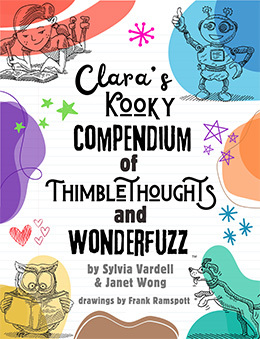
My friend Sylvia Vardell and I have a new book coming out soon: Clara’s Kooky Compendium of Thimblethoughts and Wonderfuzz (Pomelo Books). It’s an anthology of approximately one hundred poems by a terrific roster of new and established poets. The poems are tied together with text written by me in the voice of the main character Clara, in addition to assorted quirky facts (“thimblethoughts”) and lighthearted questions (“wonderfuzz”) written by me and Sylvia.
The format of the book is a notebook (or compendium, thanks to the many lists of information and the large number of little facts sprinkled throughout). The book is structured so that it can function easily as a mentor text if teachers want to use the ready-made prompts for writing exercises. Clara’s “work” can be shared to give young writers examples to follow.
Where did you get your idea for a specific book of yours?The general idea to do a funny book came to me during a writer’s workshop. The writers in the room wanted to know my answer to the question, “What kinds of books need to be published nowadays? What should we be writing?” I had been sharing serious poems about kindness and respect and inclusion in my workshops, but all of a sudden it hit me: maybe what we need to focus on most at this moment is very simple. Laughter. Joy. Books that make us happy. Not necessarily books that make us roll on the floor with belly laughs, but books that are light and silly and, well, kooky. I realized that if you have kids who support each other when they’re being super-kooky, you’re going to have a room filled with kindness and respect and inclusion, too—kids who celebrate each other’s quirks.
We decided to stuff the book with facts because we’re so proud that one of our books, HOP TO IT: Poems to Get You Moving, won an award for “Best Book of Facts.” It’s very rare to have poetry books recognized for their fact content, but it’s really common to find poems that are full of embedded information about science, math, social studies, and other topics. And because readers really love the little random facts that can be found on every page of HOP TO IT, we wanted to do that with this book, too. Our made-up word “thimblethought” means little facts as small as a thimble; “wonderfuzz” means fuzzy things you wonder. The nonsensical nature of the words makes them even more fun; in the book we encourage kids to invent nonsense words, too.
If you had one piece of advice to give to a young would-be writer, what would it be?Don’t be afraid to be your weirdest, wackiest, silliest self on a regular basis; a notebook (or journal or compendium) is a perfect place to do it. Write down “what-if” wonderings and don’t worry if they make sense. Find answers to those questions and discover random fun facts by diving into books in the library and doing online research. When you find something that tickles your brain, write it down!
But here’s one thing to be careful about when you’re doing research online: Don’t believe everything you read. There are some people out there who aren’t just wacky in a fun way, but they’re actual “wackos”! They believe things that are so wrong, they’re dangerous; like, for instance, they might think that the world is flat … and you’ll fall off the edge if you travel too far … SPLAT!
Note: did you see what I did there? I played with rhyme, adding SPLAT because it rhymed with flat. You can have fun playing with rhyme (or alliteration or other poetic techniques) even when you’re writing a “regular sentence”; you don’t need to save those things for poems. Experimenting with writing is a great way to entertain yourself on a rainy day, or during a long car ride. When you know how to play with words, you will never be bored.
Particulars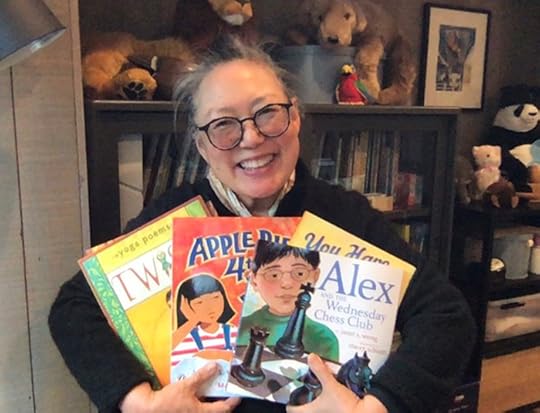
Janet Wong
Janet Wong is the author of more than 40 books, including You Have to Write. She is the winner of the NCTE Excellence in Poetry for Children Award, a lifetime achievement award that is one of the highest honors a poet can receive.
Home Twitter InstagramAugust 13, 2024
Summer Blog Series: Gordon Korman
From Avi: As I did in the summer of 2023 and the summer of 2022, I’ve invited 13 admired middle grade authors to write for my blog for the next three months. I hope you’ll tune in each Tuesday to see who has answered these two questions we’re frequently asked by readers. You should have a list of terrific books to read and share by the end of the summer … along with new authors to follow!
Where did you get your idea for a specific book of yours?
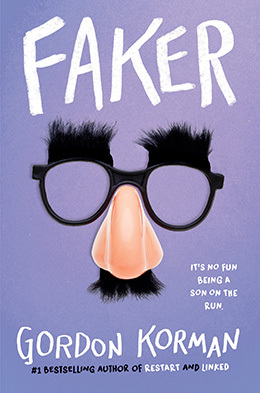
Let me say this first: I’m not a criminal. I don’t have a dishonest bone in my body. I speak up when a friend hands me an extra two dollars change in a game of Monopoly. But I got the idea for Faker when I started wondering: What happens when fate forces ordinary people to break the law? How would it feel to be an honest kid in a crooked world? Trey, the main character, has always known what his father’s job is: Professional con artist. But as he gets older, he comes to realize that he’s Dad’s main partner in crime. All writers have to be a little cruel to their characters – that’s what makes a story interesting. I put Trey in an impossible bind. He knows his father’s business is wrong, but how can he go against it without destroying him, maybe even landing him in prison? How do you get you family to stop lying when your lives depend on it?
If you had one piece of advice to give to a young would-be writer, what would it be?My advice would be to start thinking of full stories, rather than just ideas. An idea can be anything; a story has a beginning, middle, and end. The beginning is the starting point, but where are you planning to go from there? Is there a goal, a journey, a problem to solve, or a conflict that needs resolution? You don’t have to know the exact ending, but you want a sense of where the plot is heading. And once you have that, try to come up with two or three big scenes or moments that can happen along the way. At least that’s what works for me. Kids tell me things like, “Oh, I’m too lazy to make an outline,” but I think the opposite is true: I make outlines because I’m lazy. Planning your story will save you far more work — and heartache — in the long run.
Particulars
Gordon Korman
(photo: Sonya Sones)
Home Facebook InstagramAugust 6, 2024
Summer Blog Series: Caroline Starr Rose
From Avi: As I did in the summer of 2023 and the summer of 2022, I’ve invited 13 admired middle grade authors to write for my blog for the next three months. I hope you’ll tune in each Tuesday to see who has answered these two questions we’re frequently asked by readers. You should have a list of terrific books to read and share by the end of the summer … along with new authors to follow!
Where did you get your idea for a specific book of yours?

I write books to make sense of the world — this gloriously weird, sometimes heartbreaking, marvelous place we call home. Years ago on a visit to a St. Louis museum, I heard a talk about charlatans (people who intentionally deceive others for their own personal gain). It stirred up all sorts of questions for me:
Why would a person choose to trick others? Why do we believe the things that we do? What might we be willing to try to “fix” the things about ourselves that make us unhappy or even afraid?
Exploring these questions led me to Miraculous, a novel that Publishers Weekly described as “a historical thriller [and] chilling adventure” and that Kirkus Reviews called “a deliciously sinister read.”
Here’s a synopsis:
Thirteen-year-old Jack knows what cured his baby sister when his family thought she might never get well — Dr. Kingsbury’s “Miraculous Tonic.” Guaranteed to relieve maladies known to man or beast, Dr. Kingsbury’s potion can cure everything from pimples to hearing loss to a broken heart, and Jack himself is a witness to the miraculous results and the doctor’s kindness. When he had no money, the doctor didn’t turn him away but gave him the tonic for free along with a job — to travel with him from city to city selling his cure-all elixir.
When Dr. Kingsbury and Jack arrive in Oakdale, the town at first feels like any other they’ve visited. But it’s clear Oakdale is a town with secrets, and its citizens are slow to trust strangers.
Then Jack meets Cora, and a friendship neither expected starts to bloom. Together they uncover something else they didn’t expect — not only secrets about the town but also Dr. Kingsbury. As they race to discover the truth, they’ll have to decide who and what to believe before it’s too late.
What I didn’t know when I first started writing Miraculous was how personal the book would become for me.
Almost twelve years ago my husband, Dan, was diagnosed with early-onset Parkinson’s Disease a few weeks before his thirty-ninth birthday. Parkinson’s is a movement disorder characterized by tremors, stiffness, difficulty moving the body, and problems with balance. Most people with Parkinson’s are in their sixties or seventies or eighties, not dads with young children.
A few months in, Dan’s neurologist asked if we’d talked about Parkinson’s with our boys (who were nine and eleven at the time). We told her we’d explained to them that Parkinson’s wasn’t a disease someone died from but something they lived with. We said we didn’t know what the future would look like, but that Dad would get worse as the years passed. Most importantly, we told them it was okay to feel worried or confused or mad or scared or embarrassed, that those were normal feelings and they could talk to us and ask questions any time they needed to. We talked to their teachers, too, to let them know what was going on at home and asked them to be in touch if they saw any changes in our sons.
Good, Dan’s neurologist said, because I once had an early-onset patient who decided he’d hide the disease from his children.
I’ve never forgotten those sad words. What would make someone feel this was the best (or maybe their only) option? How could someone hide a condition where their body worked to betray them?
Years later, as I started Miraculous, the story of this father came back to me. Because a charlatan selling a cure-all tonic wants customers who feel needy or weak, the sort who are willing to try anything. So I gave Walter Ogden, the young teacher in my book, the shaking palsy (what Parkinson’s was called long ago). He’s convinced he’ll lose his job if anyone notices and sets all his hope on Dr. Kingsbury’s miracle cure.
I hope readers who pick up Miraculous consider the power of persuasive personalities like Dr. Kingsbury. I’d like them to see that while advertising techniques of the past might seem extreme or less polished than what we see today, there are still many similarities, especially when it comes to products that promise to “fix” us. And ultimately I hope readers realize there is no shame in being imperfect. (Spoiler alert: No one is perfect.) All of us have worth, no matter our abilities.
If you had one piece of advice to give to a young would-be writer, what would it be?Here’s a little secret. I love to write, but it’s not always easy. Sometimes writing a book feels like an impossible task. When that happens, I stop using the “w” word entirely. Instead I say I’m playing with words. I’m experimenting or practicing or tinkering. When you’re playing and experimenting, there are no mistakes, just chances to learn new things. This really takes the pressure off.
If writing ever feels hard, I encourage you to try it!
Particulars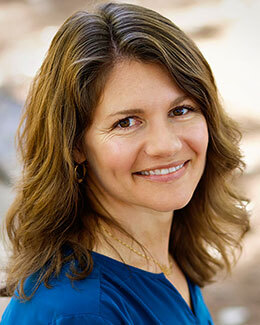
Caroline’s next book, The Burning Season, coming May 2025, is a survival story in verse about a girl who’s been raised in a fire tower in New Mexico’s wilderness.
Caroline Starr Rose
HomeAvi's Blog
- Avi's profile
- 1703 followers



